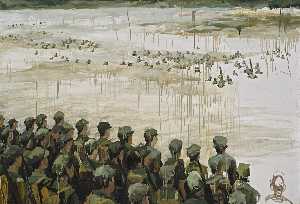Li Songsong
Li Songsong
Biography:
Li Songsong is a painter working in Beijing.
His paintings recreate public resource images of modern Chinese history, such as the National People's Congress. Li works on large scale canvases with oil paint. Li Songsong's painting The Decameron sold for $273,600 US Dollars at Christie's auction house in 2006.
Li graduated from the Subsidiary School of the Central Academy of Fine Arts (CAFA) located in Beijing in 1996 and received his Bachelor of Fine Arts degree in oil painting from the Central Academy of Fine Arts. He was one of the first Chinese artists to establish a studio in the 798 Arts District of Beijing in 2002. Li is known as a history painter because he bases his work on a wide range of Chinese history, with an emphasis on modern Chinese history He uses images primarily from newspapers, magazines, the internet, book, and film stills. Despite this heavy use of political images, Li does not consider himself a political artist. His deconstruction of the images removes bias and invites interpretation. His favorite artist, however, is politically outspoken Ai Weiwei. He has been called a member of China's "in-between" generation. This is because Li, born into a well-placed military family, was too young to have experienced life under Mao Zedong but old enough to remember the Tiananmen Square uprising, which occurred while he was attending China's CAFA-affiliated high school.
"He's a member of China's 'in-between' generation — too young to have directly witnessed life under Mao, but old enough to remember the Tiananmen Square uprising — which sets him apart both from his older peers who lived through the Cultural Revolution and from younger colleagues who have known only relative openness and growing international awareness of China's experimental art scene."
In an article in Art in America author Richard Vine said, "He does not choose images to make a point; he reacts to images that trigger his strongest and most intuitive artistic responses"
Li's work is characterized by the contrast between his removed portrayal of events and expressive emotional technique. His painting style is unique in that he warps and reconstructs his images with layers of paint often section by section in an array of colors, giving the final work an abstract and ambiguous message that is left up to the interpretation of the viewer. The sections are completed methodically from top left to bottom right, giving the finished pieces a collage-like appearance. The details of the original photograph are erased while the figures are emphasized, allowing the painting to appear as either emerging or disappearing. Li uses strictly brushes to create his artwork, though many of his paintings display a variety of textures and techniques almost bursting off the surface. His medium is oil paint applied to canvas and aluminum panels. He often listens to music while working in his studio, claiming that it is indispensable to him. Li is aware of the jarring and psychological effect his paintings can have, explaining that "there's a little cognitive dissonance going on." When describing his view of his artwork, Li says, "It's like telling a story packed with violence and gore with a huge smile on your face. It's how the stories are told that attracts you, and that's the art of it. Everyone knows the story. The important thing is that way that you tell it." Li says that every stage of his artwork is important. He starts with a simple idea and his goal is to bring different people and ideas together.
"Li Songsong is concerned with the intrinsic humanity that underpins all the images he appropriates and the memories they have the potential to bring to mind in his audience."
Chinese conceptual photography became a major trend in contemporary Chinese art around the mid-90s. The interrelationship between photography and painting is a fundamental issue in contemporary Chinese art. This is because art during the post-Cultural Revolution era was dramatically affected by this interrelationship in many different ways, making it nearly impossible for photographers and oil painters to ignore. Other artists who were affected by this interrelationship and integrated it into their work included Chen Danqing, Hong Lei, Liu Zheng, Shi Chong, and Han Lei.
Li was also heavily influenced by a book series known as the "old photo craze" (lao zhaopian re) published during contemporary China. The books were published by Shandong Pictorial Press, founded in 1994, and the first three issues became instant blockbusters in the mass book market. A total of three hundred thousand copies were printed of each of the three issues, and two hundred and forty thousand copies were printed for the fourth and final issue. These four issues were published within a single year from December 1996 to October 1997 and sold more than 1.2 million copies altogether. This made the series one of the most popular publications in post-Cultural Revolution China. This caused many artists, including Li, to become interested in representing history and memory during the post-Cultural Revolution era.
More...
Wikipedia link: Click Here




